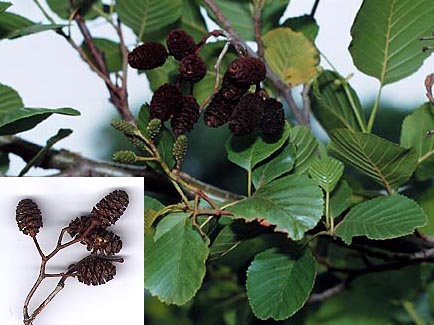
Alnus glutinosa (L.) Gaertn. (image from: http://project.bio.iastate.edu)
Alnus Species |
||
| Alders in Alaska - Alders colonizing river banks - Bonanza Creek LTER site in Alaska (Mike Anderson) | ||
| A. acuminata HBK A. crispa (Dryland in Ait.) Pursh A. glutinosa (L.) Gaertn. A. incana (L.) Moench |
A. incana subsp. rugosa (DuRoi) Spreng. A. maritima (Marsh.) Nutt. A. nepalensis D. Don A. oblongifolia Torr. |
A. rhombifolia Nutt. A. rubra Bong. A. serrulata (Ait.) Willd. A. tenuifolia Nutt. A. viridis subsp. sinuata AKA alnobetula |
(Ecology of the Alnus symbiosis)
Alnus is the only actinorhizal member of the Betulaceae. Species of Alnus are widely distributed in temperate regions of the northern hemisphere, with the exception of Alnus glutinosa (L.) Gaertn., that extends into Africa, and the Andean alder, A. acuminata HBK, that runs down the mountainous spine of Central America to Argentina. Some interesting archaeological results have suggested that the Andean alder was exploited by the Incas to fertilize and stabilize terraces in highland farming systems (Krajick, 1998). Alnus grows in a wide range of habitats, from glacial till, sand hills, and bogs to dry volcanic lava, ash alluvium, and water courses (Schwencke and Caru, 2001; Silvester, 1977). To date, all species of Alnus examined bear nodules.

The Betulaceae is comprised of 6 genera and about 130 species (Mabberely, 1988). The family is defined by the synapomorphies of male and female compound catkins and pollen morphology (Chen et al., 1999).
Angiosperm phylogenies place the Betulaceae within the Fagales in a subclade with Casuarinaceae and Ticodendraceae (Chase et al. 1993; Manos and Steele, 1997). Two lineages emerge from phylogenetic trees (Chen et al., 1999). One includes Corylus, Ostryopsis, Carpinus, and Ostrya, and the other includes Alnus and Betula. The early divergence of Alnus agrees with morphological and fossil evidence (Chen, et al., 1999). The oldest known fossil infructescence (i.e. the alder cone) for Alnus dates to the mid-Eocene (33 – 55 Mybp), but Alnus-like pollen has been reported from the late Cretaceous (83 – 85 Mybp), much earlier than fossils for the other genera in the family (Miki, 1977).
Given the distribution of known fossils and phylogenetic placements, the Betulaceae apparently originated in a Mediterranean climate in Laurasia during the late Cretaceous (89-65 mya) (Laurasia was the northern supercontinent formed after Pangaea broke up during the Jurassic and included what are now North America, Europe, Asia, Greenland, and Iceland). Fossil evidence suggests that all six genera, including Alnus, were differentiated by the early Eocene (55 mybp) (Chen et al., 1999). This observation suggests that if the ability to nodulate was ancestral in the Betulaceae, loss of that ability occurred very early on in the evolution of the family.
By the early Tertiary (65 mybp), movement between Eurasia and North America was possible, and the range of Alnus probably increased. The distribution of Alnus to Africa and to Taiwan probably occurred later, during the Pleistocene (1.8 mybp – 11, 000 ypb) when sea levels were lower (Chen, et al., 1999).
For a discussion of the ecological associations between alders and Frankia go to the the Betulaceae Frankia page. For a discussion of the evolutionary relationships between plant and Frankia go to the Frankia Phylogeny and Plant Phylogeny pages.